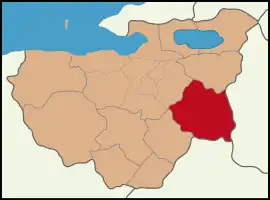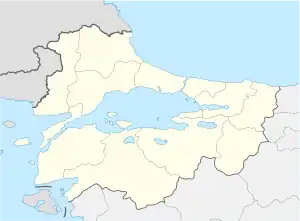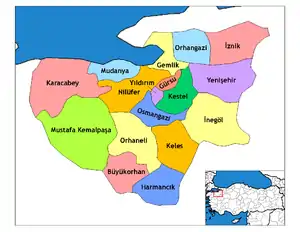İnegöl
İnegöl (known as Ἀγγελόκωμις, Angelokomis in the Byzantine period)[2][3] is a municipality and district of Bursa Province, Turkey.[4] Its area is 1,118 km2,[5] and its population is 294,485 (2022).[1] İnegöl is one of the centers of the Turkish furniture industry, and is also known for its meatball (İnegöl köftesi) which has its origins in ćevapi brought to the region by Bosnian immigrants (Bosniaks) during the Balkan Wars.
İnegöl | |
|---|---|
District and municipality | |
.jpg.webp) Inegöl İshak Paşa Külliyesi | |
 Map showing İnegöl District in Bursa Province | |
 İnegöl Location in Turkey  İnegöl İnegöl (Marmara) | |
| Coordinates: 40°04′50″N 29°30′35″E | |
| Country | Turkey |
| Province | Bursa |
| Government | |
| • Mayor | Alper Taban (AKP) |
| Area | 1,118 km2 (432 sq mi) |
| Population (2022)[1] | 294,485 |
| • Density | 260/km2 (680/sq mi) |
| Time zone | TRT (UTC+3) |
| Postal code | 16400 |
| Area code | 0224 |
| Website | www |
Although considerably quieter than neighbouring Bursa and Eskişehir, İnegöl retains sufficient attractions to make it interesting to tourists on a one- or two-day stopover, as well as possessing sufficiently unspoilt nearby natural attractions to keep one occupied for longer stays. Notable tourist attractions are the İnegöl Kent Müzesi[6] and (directly next to it) the İshakpaşa Historical Mosque.[7] Nearby to İnegöl is the health resort of Oylat (also known as the Oylat Hotspring), adjacent to the Oylat Cave. İnegöl is also conveniently located near to Uludağ, a popular skiing resort during the winter months.
History
From 1867 until 1922, İnegöl was part of Hüdavendigâr vilayet. It was captured by the Greek Army during the Greco-Turkish War (1919–1922) however it was retaken by the Turks during the Great Offensive.
Composition
There are 116 neighbourhoods in İnegöl District:[8]
- Akbaşlar
- Akhisar
- Akıncılar
- Alibey
- Aşağıballık
- Babaoğlu
- Bahariye
- Bahçekaya
- Baykoca
- Bayramşah
- Bilalköy
- Boğazköy
- Burhaniye
- Çavuşköy
- Çaylıca
- Çayyaka
- Çeltikçi
- Cemiyet
- Cerrah
- Çiftlikköy
- Çitli
- Cuma
- Cumhuriyet
- Deydinler
- Dipsizgöl
- Doğanyurdu
- Dömez
- Edebey
- Elmaçayır
- Ertuğrulgazi
- Esenköy
- Esentepe
- Eski Bahçekaya
- Eskikaracakaya
- Eskiköy
- Eymir
- Fatih
- Fevziye
- Fındıklı
- Gazelli
- Gedikpınar
- Gülbahçe
- Gündüzlü
- Güneykestane
- Güzelyurt
- Hacıkara
- Halhalca
- Hamamlı
- Hamidiye
- Hamitabat
- Hamzabey
- Hasanpaşa
- Hayriye
- Hilmiye
- Hocaköy
- Huzur
- İclaliye
- İhsaniye
- İsaören
- Karagölet
- Karahasanlar
- Karakadı
- Karalar
- Kayapınar
- Kemalpaşa
- Kestanealanı
- Kınık
- Kıran
- Kocakonak
- Konurlar
- Kozluca
- Küçükyenice
- Kulaca
- Kurşunlu
- Lütfiye
- Madenköy
- Mahmudiye
- Mesudiye
- Mezit
- Muratbey
- Olukman
- Orhaniye
- Ortaköy
- Osmaniye
- Osmaniyeköy
- Özlüce
- Paşaören
- Rüştiye
- Saadet
- Sarıpınar
- Şehitler
- Sinanbey
- Şipali
- Soğukdere
- Süle
- Süleymaniye
- Sulhiye
- Sultaniye
- Sülüklügöl
- Sungurpaşa
- Süpürtü
- Tahtaköprü
- Tekkeköy
- Tokuş
- Tüfekçikonak
- Turgutalp
- Turgutalpköy
- Tuzla
- Yeni
- Yenice
- Yeniceköy
- Yeniköy
- Yeniyörük
- Yiğit
- Yukarıballık
- Yunusemre
Furniture
İnegöl is a city surrounded rich with natural resources, especially forests, therefore wood processing businesses were always a big part of the city's economy. The first official record of wood processing business was recorded back in 1523 within Hüdavendigar cadastral record book, some of the villages were producing oars for the galleys of the Ottoman Empire.[9]
The furniture sector of İnegöl accounts for 88.5 percent of all the industrial companies.[9] Forty two percent of İnegöl's exports were furniture exports in 2019 ($574.559.944,38).[10] The city is number three in furniture exports of Turkey when ranked by total volume after İstanbul and Kayseri.
There are also 2 biggest furniture shopping malls in Turkey in İnegöl.[11][12]
Gallery
 Inegöl Yıldırım Mosque, also known as Yıldırım Camii
Inegöl Yıldırım Mosque, also known as Yıldırım Camii Inegöl city hall
Inegöl city hall Inegöl Sani Konukoĝlu Mosque, also known as Sani Konukoĝlu Camii
Inegöl Sani Konukoĝlu Mosque, also known as Sani Konukoĝlu Camii Inegöl general view
Inegöl general view Front view of Inegöl Işak Paşa Külliyesi
Front view of Inegöl Işak Paşa Külliyesi
Notable people
Notable residents include Mustafa Ülgen, an orthodontist. A section of the İnegöl Kent Müzesi (museum) is dedicated to him.
Twin cities [13]
References
- "Address-based population registration system (ADNKS) results dated 31 December 2022, Favorite Reports" (XLS). TÜİK. Retrieved 12 July 2023.
- Korobeĭnikov, Dimitri (2014). Byzantium and the Turks in the Thirteenth Century. Oxford University Press. p. 284. ISBN 978-01-98-70826-1. Retrieved 13 August 2020.
- "İnegöl Tarihçesi — İNEGÖL ADINA DAİR". inegol.bel.tr (in Turkish). Retrieved 10 August 2020.
- Büyükşehir İlçe Belediyesi, Turkey Civil Administration Departments Inventory. Retrieved 12 July 2023.
- "İl ve İlçe Yüz ölçümleri". General Directorate of Mapping. Retrieved 12 July 2023.
- "ABOUT İNEGÖL". inegolkentmuzesi.gov.tr. Retrieved 10 August 2020.
- "About İshakpaşa Mosque". bursa.com.tr/. Retrieved 16 March 2022.
- Mahalle, Turkey Civil Administration Departments Inventory. Retrieved 12 July 2023.
- "Furniture Market of İnegöl". Eurus Concept.
- "İnegöl 2020 Ekonomi Raporu" (PDF).
- "Mobilimo". Mobilimo.
- "Mobiliyum". Mobiliyum.
- "Friend Cities". inegol.bel.tr.
